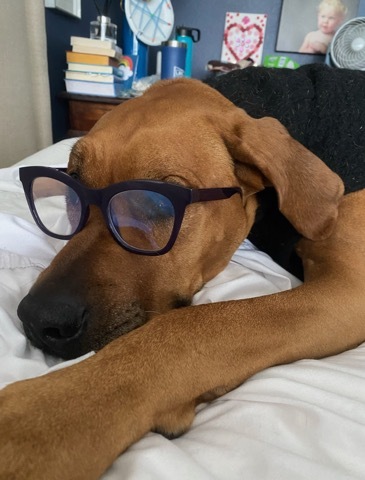
Buddy is our Pet of the Month for January. He is a 125# Rhodesian Ridgeback who has been dealing with an ear hematoma that has been challenging to get resolution. Back in September of 2022 he developed an ear hematoma, and on the advice of a well-meaning neighbor, the owner thought it would go away. However, Buddy continued flapping his ears and the hematoma got worse. After seeking veterinary care, it was determined that had infections in both ears, and the flapping created the hematoma. Fortunately, getting the proper medications for the infection, having the fluid drained and treated with a steroid injection, the hematoma resolved, for a couple months.
Has your dog ever had an ear infection? Do they flap or scratch at their ears? Do you know about ear hematomas when the ear balloons up like a pillow?
Ear hematomas occur for a variety of reasons, most often secondary to ear infections and flapping the ears. Yet, bite wounds, trauma from an injury, parasites, scratching at the ears, and underlying immune changes (allergies) are also be contributing factors.
There are many blood vessels in an ear flap, part of the mechanism that helps animals cool themselves. When those blood vessels leak, the bloody fluid builds up between the skin and the cartilage. It can occur in one small spot, or it may involve the entire ear pinna and they are painful.
Most commonly hematomas affect dogs with pendulous ears, but cats and dogs with upright ears can also be affected. Treatment is focused around resolving any ear infection, preventing additional build-up of fluid, stopping self-trauma, and helping the ear tissues to adhere and form sufficient scar tissue to achieve more permanent resolution. This can take weeks.
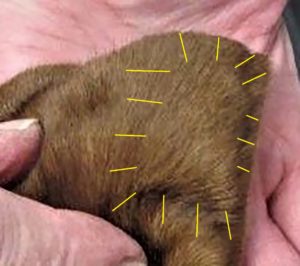
Yellow lines show the small hematoma at the tip of the ear flap
Veterinarians know that often dogs with one hematoma can be at risk for developing another. This is what happened with Buddy. At the end of December, Buddy had a recurrence. There was a small pocket of fluid in the tip of his left ear. The ear was not painful at this point, and the ear canal only had a scant amount of wax with no indication of repeat infection. Depending on the ear, the patient and other factors, there are a variety of approaches to treat ear hematomas; all with pros and cons that have to be considered. Because he healed well previously, we decided that the minimally invasive treatment of draining the fluid and giving another steroid injection was a good decision.
Unfortunately, several days later, Buddy’s entire ear flap became swollen, warm to the touch and painful. The owners took him to the ER where the decision was made to surgically repair the ear. An ‘S’ incision was made on the inner aspect of the ear flap to drain all the accumulated fluid and the ear flap was sutured. Buddy was started on antibiotics for the ear and pain medications to keep him comfortable. The ear was bandaged to his head and he was sent home with an Elizabethan Collar.
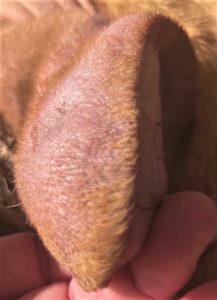
Picture of the swollen ear flap before surgery
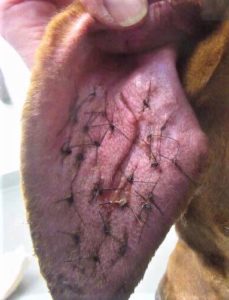
Ear after surgery at the ER showing ‘S’ shaped incision to drain fluid

Buddy with his first ear wrap and ‘party hat’ to prevent him shaking head
We saw Buddy for a recheck 5 days later. The ear flap had come loose from the head bandage and was still oozing some bloody discharge. As a precaution, we checked his blood clotting times, which were normal, to ensure there wasn’t a more serious underlying disease contributing to the ear swelling. We bandaged the ear flap around a roll of cotton to stabilize the flap and prevent additional trauma.
We recommended that the owner purchase a No Flap Ear Wrap®. We had a little miscommunication because when the owner googled the item, she found there are a lot of products that claim to prevent ear flapping, and the item she purchased just wasn’t strong enough for Buddy’s ear and his head size.
Despite the owner’s best efforts at providing the appropriate home care, by the middle of January, Buddy’s ear had swollen up again and was quite painful. The ER docs said, if the ear flap was continuing to swell, it might require amputation. The owner wasn’t ready for that, so we decided we would try another surgery, remove the previously placed sutures, drain the ear and replace through-and-through sutures in the flap.
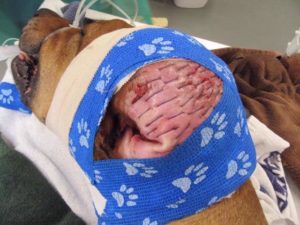
Head wrap after second surgery with ear opening exposed
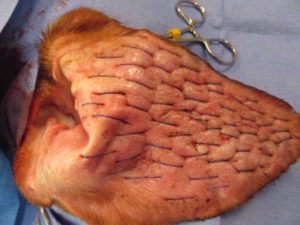
Ear flap after dozens of new sutures placed
With Buddy under anesthesia, we placed almost 5 dozen quilting sutures in the ear flap. Then we taped the ear up over the top of his head with a thick pad of cotton underneath to support the ear. By leaving the ear canal exposed the owner was able to instill ear medications and we could monitor the healing during subsequent rechecks. Buddy was placed on oral antibiotics, pain medications, and oral steroids to reduce the ear swelling and help it heal.

Buddy showing off his stylish head wrap post surgery
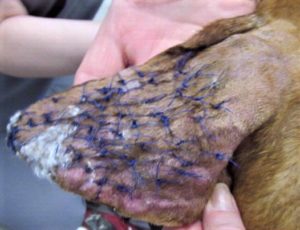
The outer ear flap showing suture knots (and some left over cotton) after the head bandage was removed. Swelling has gone down.
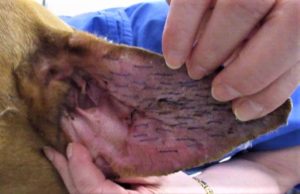
Inner aspect of the ear flap; almost all swelling has resolved
Buddy has made remarkable improvement, and while his healing isn’t finished, the ear looks better, and he is more comfortable. We are very optimistic that he will make a full recovery.
We’ll still need to keep a close watch on his ear health with regular home ear cleaning and managing any infections that may recur. We will also monitor him for signs of allergies going forward.

Buddy modeling his No Flap Ear Wrap over the head bandage

